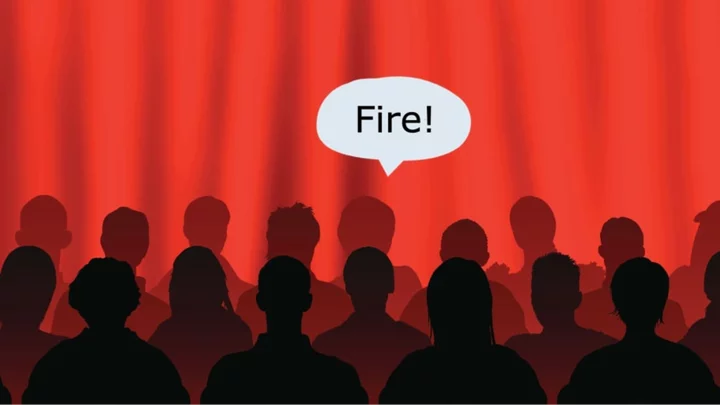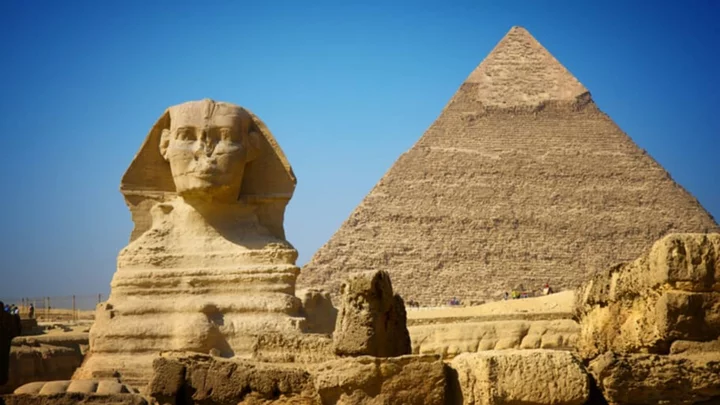Ghosts, ghouls, and monsters turn up everywhere at Halloween—including in our language. From treacherous underground goblins to ghostly roaming primates, here are the spooky origins of 10 familiar words.
1. Aghast
Although it’s used much more loosely in English today, the word aghast literally means “frightened by a ghost.” That’s because the ghast part of of aghast is a derivative of the Middle English word gæsten, meaning “to terrify,” which is in turn a derivative of gæst, the Old English word for “ghost.” The gast of flabbergast, incidentally, probably comes from the same root.
2. Larva
In Latin, larva originally meant “ghost” or “ghoul,” and when the word first began to be used in English in the mid-1600s, that’s also what it meant. But because the ghosts and ghouls of antiquity were often portrayed as wearing a disguise to hide amongst the world of the living, in Latin larva also came to mean “mask,” and it was this figurative sense that the 18th-century naturalist Carl Linnaeus meant when he began to call the juvenile forms of insects larvae in the 1700s.
3. Bugaboo
Bugaboo has been used since the early 1700s to refer to an imagined problem or bugbear (although oddly, in 19th century English, it was also used as a nickname for a bailiff). The word itself has two possible origins, both of which are equally ghoulish: It might come from an old Celtic word (most likely bucca-boo, an old Cornish word for a devil or spectre), or it might come from “Bugibu,” the name of a monstrous demon that appeared in a Medieval French poem, Aliscans, written in the mid-1100s.
4. Lemur
Carl Linnaeus was also responsible for the word lemur, which he stole from the ghoulish Lemures of Ancient Rome. To the Romans, the Lemures were the skeletal, zombie-like ghosts of murder victims, executed criminals, sailors lost at sea, and anyone else who had died leaving unfinished business behind them on Earth. According to Roman tradition, ultimately the Lemures would return to haunt the world of the living each night—and hence when Linnaeus discovered a group of remarkably human-like primates wandering silently around the tropical rainforests in the dead of night, he had the perfect name for them.
5. Cobalt
The chemical element cobalt takes its name from the kobold, a type of devious subterranean hobgoblin in German folklore. Described in Sir Walter Scott’s Letters on Demonology and Witchcraft (1830) as “a species of gnomes who haunted the dark and solitary places,” the kobolds were once believed to inhabit the rocks and tunnels of mineshafts, where they would reward those miners who respected them with rich discoveries, and would punish any others with rockfalls, poisonous fumes, and underground fires.
The kobold’s connection to cobalt stems from the fact that two of the element’s most important ores—namely cobaltite and smaltite—both contain an equivalent amount of arsenic, which makes mining for them a particularly hazardous business. Long before the harmful nature of these metals was known to science, however, any miners who fell ill collecting cobalt would be left with little option but to blame their misfortune on the treacherous kobolds.
6. Mascot
We might use it more generally to mean an emblem or symbol, but a mascot was originally a talisman or charm, namely something intended to be used to protect someone from harm. In this sense the word is derived from masca, an old Provençal French word for a witch or sorceress.
7. Mindboggling
The boggle part of mindboggling is derived from an old Middle English word, bugge, for an invisible ghost or monster. These bugges (or “boggles,” as they became known) could not be seen by human eyes, but could supposedly be seen by animals: A spooked horse that reared up for no apparent reason would once have been said to have seen a bogle.
8. Nickel
Like cobalt, nickel takes its name from another ghoul from German folklore, known as the Kupfernickel, or “copper-demon.” Unlike the kobolds, however, nickels were more mischievous than dangerous and would simply trick unsuspecting miners into thinking they had discovered copper, when in fact they had discovered nickel, which was comparatively less valuable. Like the kobolds, however, the nickels had to be placated and respected, lest they cause cave-ins or other underground disasters.
11. Zeitgeist
If a poltergeist is literally a “noisy ghost” in German, then a zeitgeist is simply a “spirit of the age”—that is to say, something that seems to sum up the era in which it exists.
12. Terabyte
The tera in words like terabyte, terawatt, and terahertz is derived from the Greek word for “monster,” teras. The words teratism, meaning “a monstrosity,” and teratology, “the study of biological abnormalities,” are derived from the same root.
A version of this story ran in 2016; it has been updated for 2023.
This article was originally published on www.mentalfloss.com as 10 Common Words With Spooky Etymologies.









